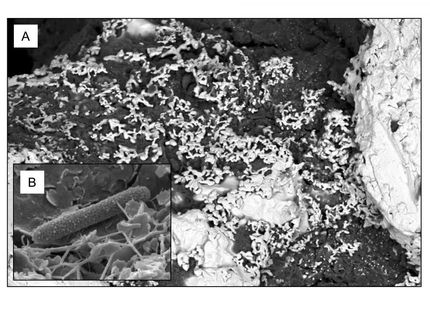How does dolomite form?
Scientists in Kiel show the influence of marine bacteria on mineral formation
Advertisement
Not only in the Dolomites, but throughout the world dolomite is quite common. More than 90 percent of dolomite is made up of the mineral dolomite. It was first described scientifically in the 18th century. But who would have thought that the formation of this mineral is still not fully understood, although geologists are aware of large deposits of directly formed (primary) dolomite from the past 600 million years. The process of recent primary dolomite formation is restricted to extreme ecosystems such as bacterial mats in highly saline lakes and lagoons. "As these systems are very limited in space, there is an explanation gap for geologists for the widespread presence of fossil dolomite," explains Dr. Stefan Krause, Geomicrobiologist at GEOMAR | Helmholtz Centre for Ocean Research Kiel.
A team of biologists and geochemists, who are conducting research together in the Cluster of Excellence "Future Ocean", in collaboration with colleagues at the ETH Zurich and the Centro de Madrid Astrobiología, have now brought a little light into the darkness of this scientific riddle. Their findings are published in Geology.
In simple laboratory experiments with globally distributed marine bacteria which use sulphur compounds instead of oxygen for energy production (sulfaterespiration), the scientists were able to demonstrate the formation of primary dolomite crystals under conditions that prevail today in marine sediments. "The dolomite precipitates exclusively within a mucus matrix, secreted by the bacteria to form biofilms," says Stefan Krause, for whom this study is an important part of his PhD thesis. "Different chemical conditions prevail within the biofilm compared to in the surrounding water. In particular, the alteration of the magnesium to calcium ratio plays an important role. These changes allow for the formation of dolomite crystals. "
The study has provided further insight. "We were able to show that the ratio of different isotopes of calcium between the ambient water, the biofilm and dolomite crystals is different," explains Dr. Volker Liebetrau from GEOMAR. "This ratio is an important tool for us to reconstruct past environmental conditions. The fact that bacteria are involved in this process allows more precise interpretations of climate signals that are stored in rocks. "
Evidence of primary dolomite formation by a process as common as microbial sulphate respiration under conditions that currently prevail in the seabed, provides new insights into the reconstruction of fossil dolomite deposits. But why are large scale deposits from primary dolomite no longer formed at the ocean floor? "Here we are still faced with a puzzle," says Professor Tina Treude, head of the Working Group at GEOMAR. "One possibility is that massive primary dolomite can form particularly during times when large quantities of organic matter in the seabed are degraded by sulfate-respiring bacteria. Such conditions exist when the sea water above the seafloor is free of oxygen. In Earth's history, several such oxygen-free periods have occurred, partly consistent with time periods of intensified dolomite deposition. "

































































